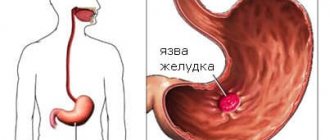Most of the pathological conditions of the upper part of the digestive system are caused by the influence of pathogenic microorganisms that live in the mucous membrane of the stomach and duodenum. They are located mainly in the stomach and are called Helicobacter pylori. Accurate diagnosis of these microorganisms is necessary to prescribe timely treatment in order to quickly normalize the condition of the upper digestive tract. The ICLINIC clinic uses a highly accurate Helpel test, which allows you to give an unambiguous answer within a few minutes regarding the presence of these bacteria in the gastric mucosa.
Indications for testing for Helicobacter pylori
A breath test for Helicobacter pylori is indicated when the first signs of infection appear in the body. The bacterium can be present in the digestive system for a long time without symptoms. The absence of negative symptoms indicates the patient’s good immunity. With such factors, Helicobacter does not cause harm to the body. As soon as bacterial activity increases, the digestive system malfunctions. This factor indicates a weakening of the immune system and the need to identify the cause of the condition.
Indications for prescribing the test:
Bad breath in combination with other signs of possible pathology of the digestive tract is an indication for a breath test. Regular pain in the intestinal or stomach area;- pain in the digestive organs that occurs in the morning or after eating food;
- worsening appetite and sudden loss of body weight (in combination with additional symptoms);
- heartburn, flatulence, bloating and other abnormalities in the gastrointestinal tract after eating meat products;
- the presence of bad breath and white coating on the tongue;
- regular deviations in the process of bowel movement (diarrhea, constipation);
- identification of pathologies of the digestive system (malignant formations, chronic diseases);
- after eating food, the patient experiences vomiting or nausea;
- the presence of serious gastrointestinal problems in close relatives.
ELISA analysis
An enzyme-linked immunosorbent assay (ELISA) is necessary to determine whether a person has antibodies to the bacterium Helicobacter pylori. That is, not the pathogen itself, but the immune cells that the body begins to synthesize when an infectious agent enters. These antibodies are produced by plasma cells formed from B lymphocytes. During laboratory testing, they can be detected on the surface of B lymphocytes and in blood serum.
Another name for protective cells is immunoglobulins. There are five types of such cells in humans and mammals. They are designed to combat various viruses and bacteria. When it comes to Helicobacter, it is customary to talk about such types of protective cells as LgG, LgM, LgA. It is these three species that take an active part in the fight against the bacterium.
The essence of the methods
A breath test is a safe procedure. The technique does not imply physical or psychological discomfort for the patient. There are two main testing options - the helic test and the C-urease test.
The methods differ in the type of component that reacts with air and is used for research.
C-urease breath test
Helicobacter pylori produces a special type of enzyme - urease. The substance accelerates the hydrolysis of urea. This process is accompanied by the active production of ammonium and carbon dioxide. If there are no pathogenic microorganisms in the patient’s digestive system, then there is no urease in the stomach. The examination takes on average forty minutes.
Testing reliability reaches 95%.
Testing stages:
- the patient takes a capsule with a carbon-labeled urea reagent);
- if Helicobacter pylori is present in the body, then after thirty minutes carbon dioxide and ammonia will begin to be present in the exhaled air;
- a special device records all changes;
- if carbon dioxide and ammonia are absent in the air, then the test result is negative (Helicobacter was not detected).
Breathing Helic test
The reliability of the helic test is 75%. Air testing is also carried out based on the ability of a microorganism to produce urease. To carry out the procedure, a urea solution is used. If the bacterium is present in the body, then under the influence of this substance ammonia vapor will appear in the exhaled air. Testing is carried out using an indicator tube. Ammonia vapor changes the color of the indicator.
Breath test for Helicobacter pylori (Hp+ or Hp-).
How to prepare for research
Preparation for the breath test should begin the day before the procedure. If at the time of testing the patient is undergoing drug therapy, then the date of the test is set by the doctor after the end of the course of medication.
Violation of the preparation rules may cause a decrease in the reliability of the results. Before the analysis, it is recommended to brush your teeth and rinse your mouth.
Preparation stages:
- the procedure is carried out on an empty stomach in the morning;
- if the test is carried out in the morning, then the last meal should be taken no later than 21:00 of the previous day;
- Do not drink water for an hour before the procedure;
- the diet the day before testing should exclude any legumes (regardless of the method of preparation);
- do not smoke on the day of testing;
- three hours before the procedure, you should not chew chewing gum;
- the test cannot be performed during drug therapy;
- taking medications ends two weeks before the procedure;
- at least three days before the procedure, it is prohibited to drink alcoholic and carbonated drinks;
- Dishes present in the diet during the day before the procedure should be easily digestible and digestible.
Recommendations for preparing for the test.
How the research is carried out
Breathing tests are carried out over a short period of time. Helic test and C-urease testing are carried out using different devices. In the first case, the results are deciphered immediately, in the second case they are compiled by laboratory specialists. During the procedures, it is important to follow all the rules. If you violate the algorithm of actions, the results may become unreliable.
C-urease breath test
Before the C-urease test, the patient should drink a glass of orange juice. If there are contraindications to the use of such a drink (for example, an allergy to citrus fruits), then it is replaced with an apple version. Next, the patient must hold his breath for a few seconds. The air is exhaled into a special bag. The device is immediately sealed hermetically.
Further:
- the patient takes a capsule or solution based on urea;
- the substance should spread throughout the mucous membranes of the stomach (the patient is asked to turn over from one side to the other);
- after half an hour, the procedure with exhalation of air into the bag is repeated;
- in some cases, air is taken twice with an interval of ten minutes;
- Determination of changes in the composition of exhaled air is carried out in the laboratory.
Helic test
The bacterium Helicobacter pylori is the cause of most cases of stomach and duodenal ulcers, as well as chronic gastritis with low acidity. The helix test is carried out using a tube equipped with an indicator. The device is placed in the patient's mouth for seven minutes. The main rule is that inhalations and exhalations are carried out as usual. No saliva should get into the tube.
Otherwise, test results may become unreliable. At the second stage of the procedure, the patient takes a special solution. You should breathe into the tube again for the next seven minutes. The doctor records all changes in the air based on the indicator readings. If necessary, testing is repeated after thirty minutes. For example, if saliva gets into the tube.
Express diagnostics of Helicobacter at the Paracelsus clinic, Sergiev Posad
ATTENTION:
You can independently make an appointment with a doctor and for a diagnosis of COVID-19 in the Mobile application "PARACELSUS Clinic"
Online consultations with doctors (more than 18 specialties) are available.
If you are worried about abdominal pain, heartburn, nausea, rapid satiety after eating, belching, then the main cause of these complaints may be Helicobacter pylori infection - the main causative agent of chronic gastritis and stomach ulcers.
Once in the stomach, Helicobacter pylori multiplies and destroys the cells of our stomach, causes chronic inflammation and leads to gastritis, contributes to the appearance of ulcers, and also increases the risk of developing stomach cancer.
Timely detection of this bacterium and effective treatment can prevent diseases and their complications.
Today we offer you modern express diagnostics of helicobacteriosis infection using the respiratory method.
results
You don't have to wait long for breath test results. The helic test is deciphered during the testing process. The study of the indicators of the C-urease procedure is carried out within several hours. In most cases, the transcript will be received on the day of testing.
The study results are the basis for drawing up a treatment regimen for the attending physician.
C-urease test for Helicobacter
The results of C-urease testing are compiled based on a comparison of two air samples. A reading below 0.3 ppm indicates the absence of bacteria in the patient’s body. Higher numbers are always considered confirmation of infection. Based on the degree of deviation from the norm, the intensity of bacterial activity can be determined.
Decoding the results:
- an indicator of up to 3.5 ppm indicates the inactive phase of the bacterium;
- an indicator of up to 6.5 ppm indicates the beginning of the activity of pathogenic microorganisms;
- an indicator of up to 9.5 ppm confirms the severe degree of infection of the patient;
- an indicator of up to 15 ppm is considered the most dangerous.
Helic test
The helic test does not show the degree of intensity of infection of the body by pathogenic microorganisms. This procedure only indicates the presence or absence of bacteria in the stomach. The method for collecting results depends on the type of apparatus that was used to collect air. If a tube was used, the presence of bacteria is determined by the indicator. When using a tube connected to a digital device, the results are calculated by the device itself.
What can affect the reliability of the results?
Preparation measures for breath tests play a key role in the level of confidence of the results. If the patient did not follow proper nutritional rules, took medications or alcohol, then testing may be useless. The second reason for the unreliability of the results is a violation of the algorithm of actions during procedures. For example, saliva that gets into the tube or too sharp inhalations and exhalations can make diagnosis difficult.
Features of the helic test
So how is the Helicobacter pylori test performed?
Under the close attention of a specialist, who, before starting testing, must explain the procedure and the characteristics of behavior during it. Helik systems are presented in two versions.
The first one is with an indicator tube, with its help the entire test lasts 15 minutes.
The second option is with a digital device, here it will take only 9 minutes to get the result, which will be reflected in the form of a diagram on the monitor.
Research algorithm:
Stage 1 - 6 minutes
The patient is placed comfortably, and the doctor gives him a plastic tube. You need to place it in your mouth and breathe normally. It is not advisable for the tube to touch the palate or tongue, as saliva may get into it. If too much saliva has accumulated, you are allowed to remove the tube, swallow the accumulated liquid and then continue the test.
Stage 2 – also lasts 6 minutes
The doctor gives you a safe urea solution to drink and the tube is put back in.
The specialist supervising the study must warn the patient that during the process you need to sit as calmly as possible and practically not move, since physical activity can become a distorting factor for the results.
Which doctor should I contact?
If symptoms of Helicobacter pylori infection occur, it is recommended to consult a gastroenterologist. The doctor will not only prescribe all the necessary examination procedures, but will also draw up the correct course of therapy in the presence of pathologies or inflammatory processes in the digestive system.
If you have symptoms related to signs of Helictobacter pylori infection, a visit to a specialist cannot be postponed. The sooner the bacteria is identified, the easier and faster it will be to get rid of it.
Interpretation of analysis results and normal indicators
The helic test only shows the presence of bacteria in the body. Decoding the results in this case involves recording changes in the indicator by a specialist. This test does not show the degree of infection and the level of bacterial activity. The norm is the absence of changes in the indicator. The C-urease test is more informative. The indicators can be compared in the table. The norm is a zero result.
Decoding the results of the C-urease test
| 1-3.4 ppm | Mild degree |
| 3.5-6.4 ppm | Average degree |
| 6.5-9.4 ppm | Severe degree |
| 9.5 and above | Extremely severe |
Video on the topic: What test allows you to determine if a person has Helicobacter pylori
Why diagnose and treat helicobacteriosis?
Helicobacter pylori promotes the development of:
- stomach cancer
- mucosal atrophy
- peptic ulcer
- non-ulcer dyspepsia
- gastritis.
* % of cases of development of diseases associated with the bacterium Helicobacter Pylori.
The mechanism of the negative impact of Helicobacter Pylori
Helicobacter Pylori is a gram-negative bacterium that infects the stomach and duodenum. The bacterium secretes toxic enzymes that damage the cells of the stomach and duodenum.
This causes ulceration of the mucous membrane. Helicobacter Pylori delays the healing of ulcers, the unprotected wall of the stomach begins to be exposed to gastric juice, and this contributes to the transition of the disease to a chronic form. The bacterium impedes trophism and microcirculation of tissues, which in turn also interferes with the normal healing of any damage. In this case, therapy that is aimed at eradicating bacteria (their complete destruction) and normalizing regeneration mechanisms can help.





